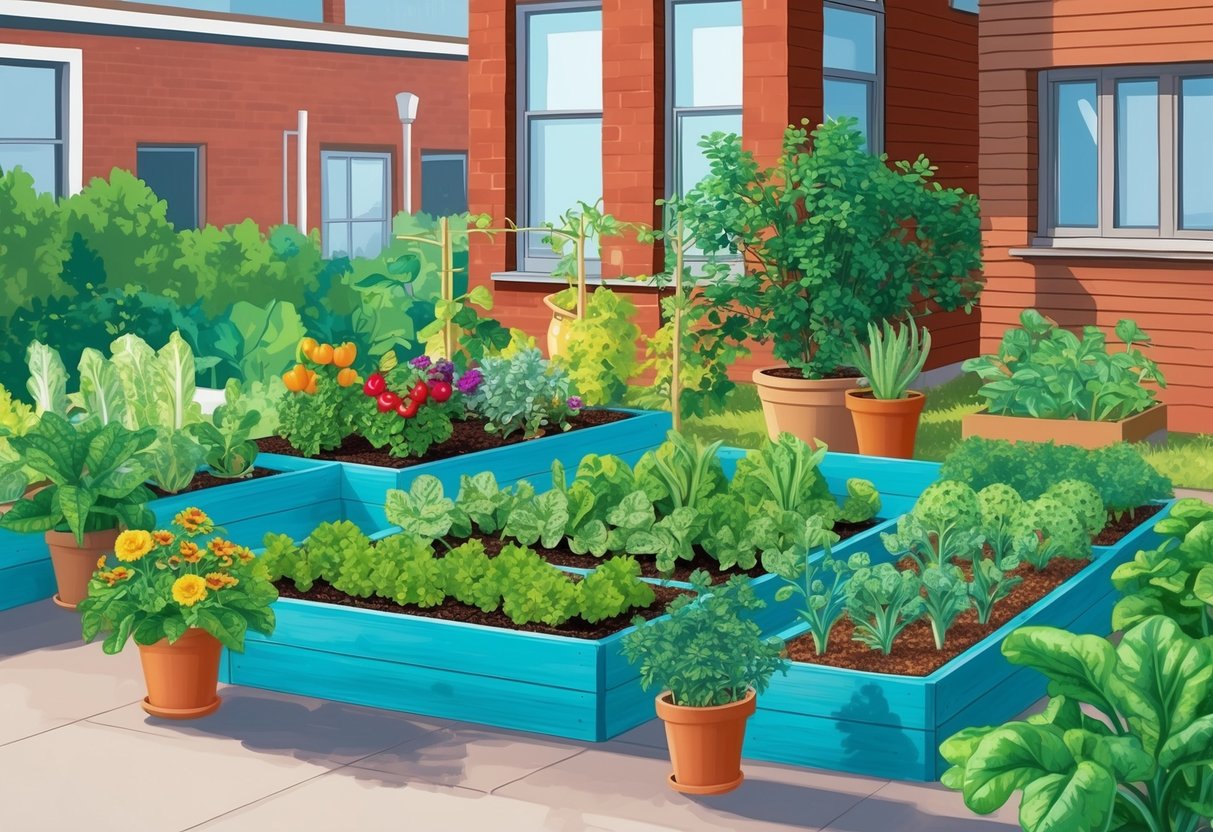
Vertical Gardening to Save Space
Vertical gardening uses upright structures to make the most of limited space. It allows gardeners to grow a range of vegetables even on balconies, patios, or small plots by guiding crops to grow up rather than out.
Best Vertical Techniques for Vegetables
Trellises are one of the most efficient ways to grow vegetables vertically. They work especially well for pole beans, cucumbers, and tomatoes.
Using a sturdy trellis system helps keep vines and fruit off the ground, improving air circulation and reducing the risk of disease. Other vertical structures such as wall-mounted planters, stacked containers, and garden towers also save space.
These are suitable for herbs, leafy greens, and compact vegetables. Vertical gardening systems can be adapted to nearly any urban or small-scale setting, including raised beds and containers, helping maximize crop yields even in tight spots.
For those with only walls or fences, options like pocket planters or vertical wall gardens provide additional growing areas. These designs are practical for small patios or balconies and ensure optimal use of available sunlight, which is crucial for healthy vegetable growth.
For more tips on space-efficient gardening, see this article about vertical gardening for small spaces.
Supporting Climbing and Trailing Crops
Climbing crops such as pole beans, cucumbers, and some varieties of peas need strong supports to grow vertically. Sturdy trellises, bamboo poles, and mesh netting are ideal choices for supporting vigorous growth and fruit production.
Tomatoes can be grown vertically using cages, stakes, or string systems. Keeping them upright prevents the fruit from touching the soil, which minimizes rot and pest exposure.
These methods also make harvesting more convenient and keep plants healthier. Trailing crops like zucchini or squash can also benefit from being elevated.
Gently training vines upward not only conserves ground space but encourages better airflow and provides easier access for watering and maintenance. Gardeners should anchor structures securely and check for stability over time, especially in windy conditions, as recommended for vertical vegetable gardens.
Soil Preparation and Fertility for Small Spaces
Proper soil preparation determines whether small gardens can achieve strong growth and higher vegetable yields. Attention to soil fertility and drainage allows even limited space to support a productive vegetable garden.
Conducting a Soil Test
A thorough soil test is the first step in preparing a small garden bed or container. Testing identifies pH, essential nutrient levels, and possible contaminants.
This information helps gardeners know exactly which amendments are necessary, avoiding both nutrient deficiencies and unnecessary applications. Testing can usually be done with an at-home kit or through a local cooperative extension service.
Gardeners should collect several samples from different spots and depths if using raised beds or planting directly in the ground. After receiving results, notes should be taken on levels of nitrogen, phosphorus, potassium, and organic matter.
Balance is essential, since imbalances can reduce growth and yields. Adjusting pH according to vegetable preference—most vegetables thrive in a range between 6.0 and 7.0—will further improve results.
Improving Soil Quality and Drainage
Small gardens and container spaces often start with poor or compacted soil, requiring amendment before planting. Improving soil structure can increase both water retention and drainage, preventing root rot while supporting steady growth.
Mixing in organic matter—like compost, aged manure, or worm castings—improves fertility and microbial activity. These additions help sandy soils hold water and nutrients, while breaking up heavy clay for better aeration.
Soil for containers should feel loose, not compacted.
Tips for improving drainage:
- Use containers or raised beds with drainage holes
- Add coarse sand or perlite to potting mixes
- Avoid overwatering and monitor for pooling
Starting from Seeds and Transplants

Getting a strong start in a small garden means understanding the advantages of both seeds and transplants. Making the right choice and knowing when and how to plant can improve yields, reduce costs, and result in healthier vegetables.
Selecting Seeds vs. Buying Transplants
Choosing between starting from seeds and using transplants depends on vegetable type, space, and budget. Seeds are often less expensive and provide a wider selection of varieties.
They’re well-suited for quick-growing crops like lettuce, radishes, and spinach. Sowing seeds directly lets plants develop strong roots and can be less stressful for them.
Transplants offer a head start for crops with longer growing seasons, such as tomatoes, peppers, or eggplants. They save weeks on the calendar, making it easier to get harvests in short growing windows.
Buying healthy transplants reduces early-care troubles, but limits you to what’s available locally. Opting for disease-resistant varieties is especially useful when space is limited.
Timing and Methods for Sowing
Timing is vital for maximizing yields in a small-space vegetable garden. Warm-season vegetables like tomatoes and peppers should be started indoors 6-8 weeks before the last expected frost.
Cool-season crops—lettuce, kale, or peas—can be sown directly in the ground as soon as the soil can be worked. Use quality seed-starting mix in trays or small pots under grow lights or on sunny windowsills for indoor sowing.
Harden off transplants by gradually exposing them to outdoor conditions a week before moving them outside. For direct sowing, space seeds properly to avoid overcrowding and promote airflow.
For vertical and intensive gardening methods, stagger sowing dates to make the most of limited beds and maintain continuous harvests. Consistent moisture, good drainage, and proper spacing all play a key role in healthy, productive plants.